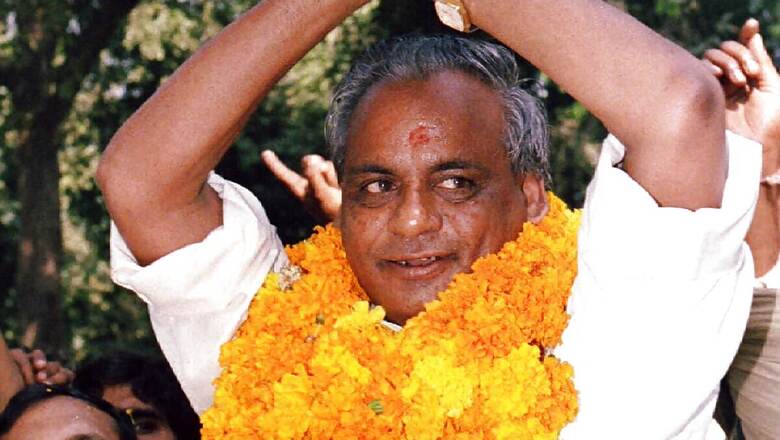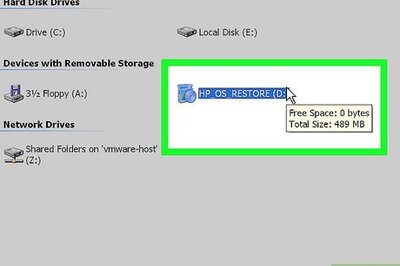
views
Kalyan Singh was understood to be the ‘real culprit’ behind the Babri Masjid demolition, but his officer in the information department, Anil Swarup, had some first-hand knowledge about what had happened on the day of demolition. Swarup later retired as the secretary of school education and literacy in the Ministry of Education. Excerpts from his book ‘Ethical Dilemmas of a Civil Servant’:
Ironically, what emerged in the judgement of the Supreme Court in 2019 was the solution that Kalyan Singh had been working on and attempting to convince various parties to come around to!
While writing the chapter on Babri Masjid titled, ‘When It All Came Crashing Down’ in my book Not Just A Civil Servant, I did face a dilemma.
Kalyan Singh was understood to be the ‘real culprit’ behind this demolition but I had some first-hand knowledge about what had happened on the day of demolition. I wondered whether that should be shared with the readers. There was nothing illegal about what I wrote but the dilemma was on account of being privy to some private conversations and whether I should release such private conversations into the public domain with a view to placing certain facts before the public.
Babri Masjid was a bone of contention between the Hindu and the Muslim communities since the 19th century. Although the disputed structure was apparently built during 1520-29 CE by Mir Baqi on the orders of the Mughal Emperor, Babar.
The mosque was located on a hill known as ‘Ramkot’.
The Hindus believed that Baqi had destroyed a pre-existing temple of Rama at the site. They also believed that Rama was born here. This belief emanates from the documents of Sawai Jai Singh. In fact, in the Kapad-Dwar collection in the City Palace Museum of Jaipur, there is a sketch map of the Babri Masjid site. The map portrays an open courtyard and a built structure resembling Babri Masjid with three domes. The courtyard is mentioned as ‘Janmsthan’ and shows a ‘Rama Chabutara’.
In 1853, a group of Hindu ascetics occupied the site and claimed ownership over the structure. In 1855, after a Hindu-Muslim clash, a boundary wall was constructed to avoid further disputes. Accordingly, the Muslims offered prayers in the inner courtyard and the Hindus on the raised platform.
The dispute acquired a legal dimension when in 1877, Syed Mohammad Asghar, the guardian of the structure, filed a petition with the Commissioner of Faizabad requesting for restraint on Hindus who had raised a Chabutara on the spot regarded as the birthplace of Ram.
In December 1949, Akhil Bhartiya Ramayan Mahasabha organized a 9-days recital of the ‘Ramcharitmanas’ just outside the mosque. On the morning of 23rd December, 1949, the event’s organisers announced that the idols of Rama and Sita had appeared miraculously and exhorted Hindus to come for ‘darshan’.
Given the sensitivity of the issue, the Government declared the mosque a disputed area and locked the gates. The unlocking of the gates took place in the year 1986 when all Hindus were given access to the site.
A massive campaign was subsequently launched to build a Rama temple on the site. It was against this background that the Bharatiya Janata Party (BJP), under the leadership of Kalyan Singh, came to power in Uttar Pradesh and I was appointed as Director, Information and Public Relations.
Kalyan Singh had taken on his job in the right earnest. He was certainly concerned about the Rama Mandir issue but on assuming office, he made his intentions clear to provide honest and purposeful governance. He was keen on conveying a message that he meant business. His vision went much beyond the Mandir.
His objective was to build a new and vibrant Uttar Pradesh.
A list of such officers who had honest credentials for manning critical posts like District Magistrates and Secretaries of Departments was drawn up at his behest. Certain social evils, like mass copying in school examinations, were sought to be reined in. The Cabinet Meetings would go on for hours, discussing policies on various issues before taking a final call.
He got a set of extremely bright officers like Sanjay Aggarwal and Anant Kumar Singh (both of whom rose to become Secretaries to the Government of India subsequently) to his Secretariat.
He was leaving no stone unturned to achieve his objective. Improvements were clearly in evidence in the form of delivery of services at the field level and in the postings of competent officers. These officers were provided security of tenure (the state was otherwise notorious for its flourishing ‘transfer industry’) and necessary backing to carry out the task of implementing policies.
He did want a grand temple at Ayodhya and was diligently working towards a peaceful and amicable consensus. There were indeed a few options emerging. One such option was the construction of a new masjid close to the site. He even gave an example of the shifting of mosques when Aswan Dam was being constructed in Egypt. This idea was gradually gaining currency. He was engaging intensively with all the stakeholders. However, he was totally against the aggressive posturing that was the hallmark of right-wing religious organisations.
Ironically, what emerged in the judgement of the Supreme Court in 2019 was the solution that Kalyan Singh had been working on and attempting to convince various parties to come around to!
However, what happened on the 6th of December, 1992, shocked him as well. Those who believe that Kalyan Singh was the man behind this demolition overlook the fact that he had an absolute majority in the assembly. Why would he want to bring his own government down in case the Masjid gets demolished? He would have surely known the consequences of the demolition. In his repeated interactions with the central leadership, he was arguing against the congregation of karsevaks at the site.
This became evident on the 6th of December in his telephonic conversation with Bhairon Singh Shekhawat, the then Chief Minister of Rajasthan. I was present when this conversation took place. Kalyan Singh was livid. He reiterated that he was against such a congregation, but he was over-ruled and no one listened to him. His reservation about such a congregation was not based on any apprehension of a mishap (he was somehow convinced that the structure will never come down in the manner it finally did) but with regard to the unnecessary distractions that such events created. He was opposed to the congregation in July as well but, fortunately, no untoward incident happened then.
The other argument often raised is, why didn’t he allow the central forces that were stationed nearby to handle the situation? It is a fact that Kalyan Singh didn’t permit the central forces to take over or seek their assistance, but it does not automatically imply that he did not allow the central forces to come in because he wanted the demolition to take place.
Kalyan Singh believed that, as in July, the karsevaks would go back after performing Pooja and that no harm would come to the Masjid. However, on this occasion he was wrong. The structure came down and, with it, brought down his government.


















Comments
0 comment